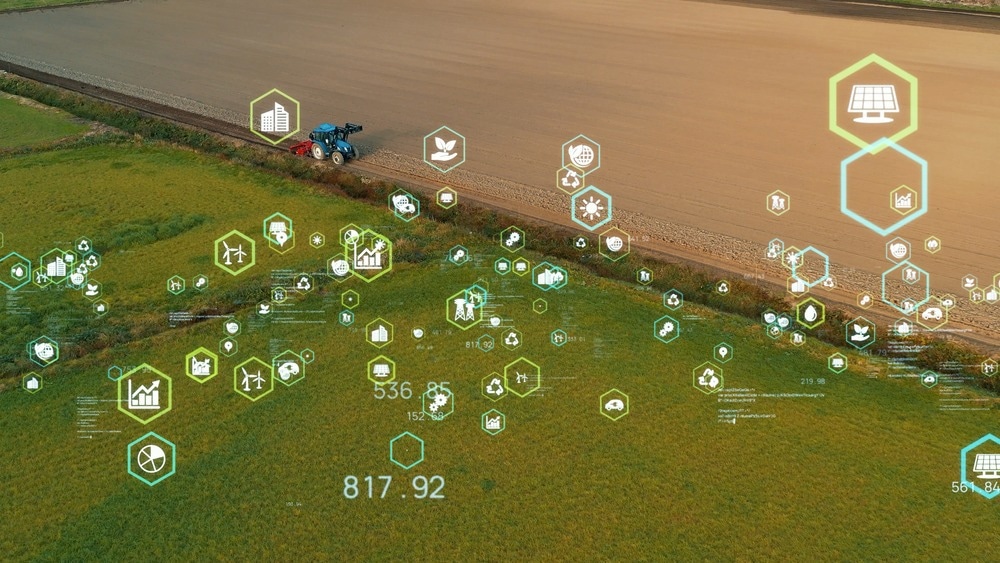Modern agriculture is facing challenges such as population growth and climate change. The application of smart technologies such as big data and machine learning are contributing to solutions by guiding decisions across farming processes. Although challenges may limit the application of these new technologies, the potential for smart farming and big data remains promising.

Digital farming. Image Credit: metamorworks/Shutterstock.com
How big data informs farming practices
The rapid technological progress over recent decades has led to the emergence of numerous innovations centered around computational tools ranging from machine learning to the internet of things and Big data. The latter refers to data sets too difficult for traditional methods to process. Specifically, big data first emerged in the early 2000s as it was first referred to by industry analyst Doug Laney, who defined big data as data characterized according to its volume, velocity, and variety.
Indeed, big data includes data from a variety of sources from different media and formats (variety) at large capacities (volume), that require high-speed processing (velocity). Many programs and analytical methods have risen as a result of the growing availability of Big data, and their applications have impacted numerous fields and disciplines.
Of particular interest, food production produces considerable data ranging from crop health monitoring to food processing, packaging, and transport. The variety of data types is also extensive, as agriculture relies on quantitative and qualitative data, imaging and satellite data, uses molecular and satellite data, and all of these across varying spatial and temporal scales. As a result, big data analysis has benefited food production by improving productivity, improving food security, and adapting to rapid environmental change.
Due to its success in analytical power, the study of big data in farming is growing in interest. A 2021 review by Laksch et al., found that over 2400 articles have been published using big data in farming sectors. The authors then examined published data to consider the changes needed to compensate for rising crop demand by 2050.
Findings showed that food production needs to increase between 25% to 70% to meet the rising demand for food in the coming decades. The review concludes by emphasizing the need to focus on developing intelligent instrumentation, sensing, robotics, artificial intelligence (AI), machine learning, big data and data analytics to improve food production. Therefore, big data is expected to play an integral part in the coming decades to support food security and improve productivity.
Applications and Implications of Big Data in Farming
Big data represents one of the three prongs involved in the technological progress in agricultural science. Together with the two other complementary elements, including Machine Learning and Internet of Things (IoT), farming is being revolutionized to become increasingly automated. In turn, so-called ‘smart’ farming enhances productivity, reduces labor costs, and reduces the carbon footprint of farming to maintain food security.
This was further discussed in a 2017 study by Alfred et al., who considered how Big Data, Machine Learning and the Internet of Things are involved in the production of rice. Authors found these elements are used across all areas of rice production including smart irrigation for paddy rice, predicting paddy rice yield estimation, monitoring paddy rice growth, monitoring paddy rice disease, assessing the quality of paddy rice, and paddy rice sample classification. Together with machine learning and IoT, big data is therefore already integrated into all aspects of farming.
Further applications of data were considered by De Alwis et al., in a 2022 review. The authors classified different types of big data used in smart farming before discussing their applications and concluding by examining machine learning techniques that are utilized in smart farming data analysis. Findings from the review demonstrate that smart farming data is associated with improved productivity, crop yield, food quality, as well as stakeholder profit, and that machine learning techniques have a number of potential directions to improve the analysis of big data.
However, despite informing farming practices and improving productivity, the 2022 study by De Alwis et al. also discussed the challenges and limitations facing big data and its role in farming. Specifically, knowledge gaps, discrepancies between stakeholders and researchers and technological limitations serve as reminders that big data remains a burgeoning field still in its infancy.

Big data. Image Credit: carlos castilla/Shutterstock.com
Limitations and Future Directions to Big Data in Farming
The challenges facing the efficacy of applying Big data to drive farming decisions were reviewed by Cravero and Sepulveda in a 2021 study. After reviewing case studies of big data in agriculture, the authors discussed the main limitations facing big data. Mainly, the authors described the limitations regarding (1) processing speed due to little control of the data in its different stages, and (2) information visualization systems, which support technical data little understood by farmers.
To address these issues, authors suggest adopting computational tools to increase processing speed, including the use of cloud computing to process and store raw data from sensors, drones, cameras and other systems. One such tool is Data Lake, which is a recent concept defined as “a large, heterogeneous, raw data storage system, powered by multiple data sources and allowing users to explore, extract and analyze data”. In turn, such tools may provide more efficient data processing as it outsources raw data to make it more easily understandable for stakeholders.
Future directions for big data are primarily based on the integration of new and improved technologies, such as hyperspectral and multispectral information processing systems. This was discussed by Ang and Seng in a 2021 study advocating for the use of complex spectral imaging systems for crop yield forecasting, crop disease detection, and the monitoring of agriculture land usage, water, and soil conditions. The authors highlight the benefit of hyperspectral image sequences to increase data generation velocity and volume, which are key elements of big data.
Ultimately, big data has emerged alongside machine learning and the internet of things as high-performance computational tools to improve agricultural processes through data analysis. This will provide key insights that may drive farming decisions, making agriculture more adaptable to challenges such as the rapidly changing environment and a growing world population.
Sources:
- Alfred, R., Obit, J. H., Chin, C. P. Y., Haviluddin, H., & Lim, Y. (2021). Towards Paddy Rice Smart Farming: A Review on Big Data, Machine Learning, and Rice Production Tasks. IEEE Access, 9, 50358–50380. https://doi.org/10.1109/access.2021.3069449
- Alwis, S. D., Hou, Z., Zhang, Y., Na, M. H., Ofoghi, B., & Sajjanhar, A. (2022). A survey on smart farming data, applications and techniques. Computers in Industry, 138, 103624. https://doi.org/10.1016/j.compind.2022.103624
- Ang, K. L. M., & Seng, J. K. P. (2021). Big Data and Machine Learning With Hyperspectral Information in Agriculture. IEEE Access, 9, 36699–36718. https://doi.org/10.1109/access.2021.3051196
- Cravero, A., & Sepúlveda, S. (2021). Use and Adaptations of Machine Learning in Big Data—Applications in Real Cases in Agriculture. Electronics, 10(5), 552. https://doi.org/10.3390/electronics10050552
- Iaksch, J., Fernandes, E., & Borsato, M. (2021). Digitalization and Big data in smart farming – a review. Journal of Management Analytics, 8(2), 333–349. https://doi.org/10.1080/23270012.2021.1897957
Further Reading
Last Updated: Oct 7, 2022